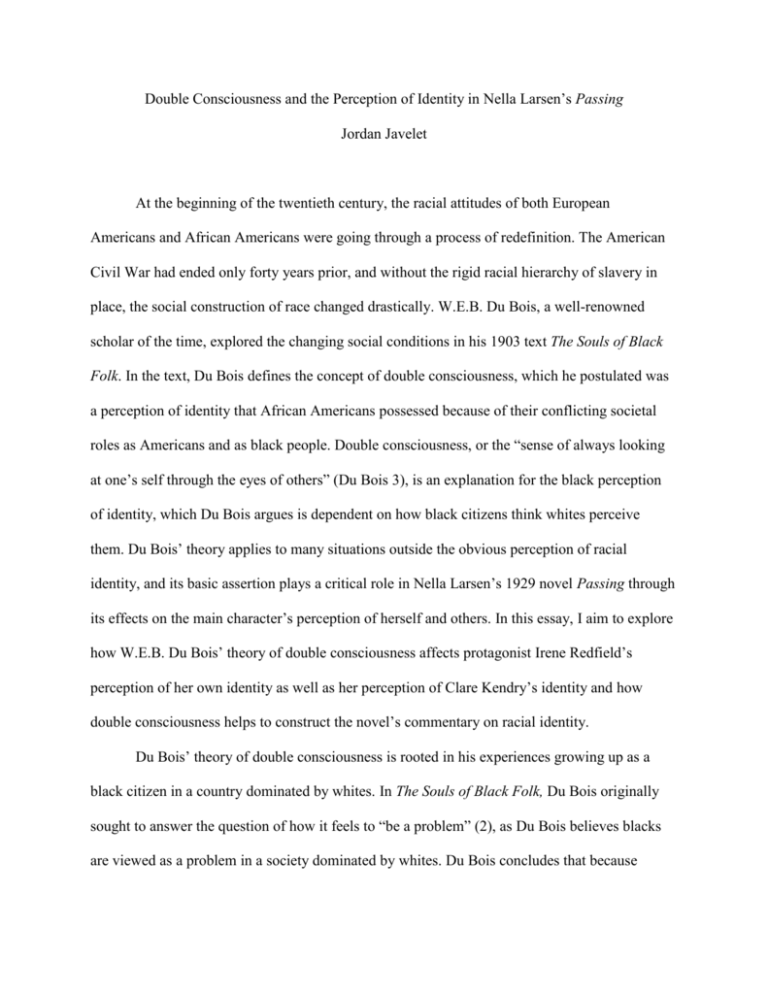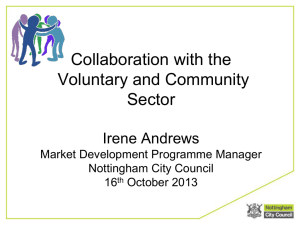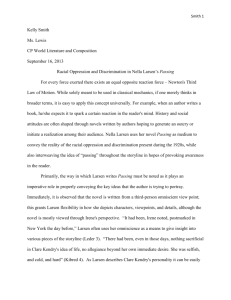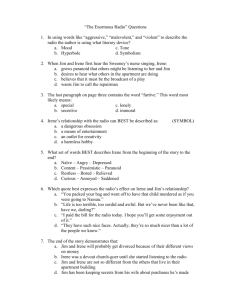Double Consciousness and the Perception of Identity in Nella
advertisement

Double Consciousness and the Perception of Identity in Nella Larsen’s Passing Jordan Javelet At the beginning of the twentieth century, the racial attitudes of both European Americans and African Americans were going through a process of redefinition. The American Civil War had ended only forty years prior, and without the rigid racial hierarchy of slavery in place, the social construction of race changed drastically. W.E.B. Du Bois, a well-renowned scholar of the time, explored the changing social conditions in his 1903 text The Souls of Black Folk. In the text, Du Bois defines the concept of double consciousness, which he postulated was a perception of identity that African Americans possessed because of their conflicting societal roles as Americans and as black people. Double consciousness, or the “sense of always looking at one’s self through the eyes of others” (Du Bois 3), is an explanation for the black perception of identity, which Du Bois argues is dependent on how black citizens think whites perceive them. Du Bois’ theory applies to many situations outside the obvious perception of racial identity, and its basic assertion plays a critical role in Nella Larsen’s 1929 novel Passing through its effects on the main character’s perception of herself and others. In this essay, I aim to explore how W.E.B. Du Bois’ theory of double consciousness affects protagonist Irene Redfield’s perception of her own identity as well as her perception of Clare Kendry’s identity and how double consciousness helps to construct the novel’s commentary on racial identity. Du Bois’ theory of double consciousness is rooted in his experiences growing up as a black citizen in a country dominated by whites. In The Souls of Black Folk, Du Bois originally sought to answer the question of how it feels to “be a problem” (2), as Du Bois believes blacks are viewed as a problem in a society dominated by whites. Du Bois concludes that because Verge 11 Javelet 2 blacks are so disdained, they are “gifted with a second-sight in this American world, — a world which yields him no true self-consciousness, but only lets him see himself through the revelation of the other world” (3). This “second-sight”—double consciousness—comes from white society forcing blacks to judge blacks using white standards that view blacks with “contempt and pity” (Du Bois 3); Du Bois states that, as a black person, “one ever feels his two-ness, — an American, a Negro; two souls, two thoughts, two unreconciled [sic] strivings; two warring ideals in one dark body, whose dogged strength alone keeps it from being torn asunder” (4). Because blacks live under white domination, their identities become split between the American identity and the African identity. Du Bois is not the only scholar to have reflected on the double identity of African Americans, whose very label of “African American” suggests an identity split between that of an African and that of an American because whites (or, simply, “Americans”) will not allow blacks to be only Americans, but must qualify them as African Americans. James Baldwin addresses similar issues in his 1951 essay “Stranger in the Village,” which evaluates how and why black racial identity (and identity as a whole) is split in two. Baldwin asserts that slavery stripped away black identity because when slaves were taken from Africa, the whites who enslaved them denied blacks their cultural history (169). In other words, blacks taken to the United States lost some of their history, cultural traditions, and beliefs. They were forced, as sociologist E. Franklin Frazier puts it, to find a “motive for living under American culture or die” (qtd. in Baldwin 170). It was this forced assimilation into American identity that led to the double identity that Du Bois describes. This forced blacks to evaluate themselves not based on their own standards, but on the standards of white Americans—in order to successfully live under American culture, blacks had to conform to white expectations and view themselves through the eyes of the dominant race. Verge 11 Javelet 3 Because double consciousness created such a conflict of self-understanding, the African American literature of the time often explored the boundaries of identity and the manifestations of white-mandated double consciousness. When racial passing became a relatively common practice, the implications of racial passing on the double consciousness were also incorporated into many novels. One such novel, Nella Larsen’s Passing, focuses primarily on the effects that double consciousness has on racial identity. The novel’s conflict is rooted in main character Irene Redfield’s internal conflict stemming from her racial identity-based moral paradox that exists due to her double consciousness. The internal conflict begins with Irene’s perception of her own racial identity and her identity as a whole. Although she has skin light enough to pass as white, with “warm olive cheeks” (Larsen 11) that could be considered the skin tone of “an Italian, a Spaniard, a Mexican, or a gipsy” (Larsen 16), Irene clearly considers her racial identity to be that of a black woman. She is married to Brian Redfield, a man too dark skinned to be able to pass, and one of her children has dark skin (Larsen 36-37). Irene is involved in the black community and attends many of the social events of upper-middle class African Americans in her peer group. She actively inhabits the role of the female caretaker of the household that she believes herself to be. She prides herself in her “special talent” (Larsen 58) for understanding her husband, Brian, and believes that this understanding is the only thing that keeps their marriage successful (Larsen 58). Despite this, the majority of the evidence in the text suggests that Irene’s rigid actions in accordance with the cult of domesticity (her attempts to act as a stereotypical middle class mother), which align her somewhat with white racial standards, actually do nothing to help her understand Brian, who is the epitome of the stereotypical black man. Brian is physically attractive, but Irene admits that he would not have been nearly as attractive if not for the “beauty Verge 11 Javelet 4 of his skin, which [is] of an exquisitely fine texture and deep copper color” (Larsen 54). Brian is masculine in that he admonishes and lectures Irene when she tries to discuss household matters with him (Larsen 54) and that he sees no problem in the crude knowledge that his son has learned about sex from the other boys at school (Larsen 58-60). Brian also desires to leave America for Brazil, a country where he and his family can foster and grow their African heritage; this desire gives Brian a Marcus Garvey-esque persona and aligns him with the Back-to-Africa movement. His unyielding persona emphasizes his strong black identity and contrasts starkly with Irene’s double consciousness-influenced actions of an “Angel in the House” archetype. Despite Irene’s “white” actions, it is clear that she views herself as black and only passes once in a while, often unintentionally and for convenience—she does not actively try to pass, but in certain circumstances, her light skin is assumed to be that of a European American (Larsen 16). Still, Irene has black ancestry, which makes her black in the eyes of the law (due to the onedrop rule) and in the eyes of the dominant race. Du Bois’ theory of double consciousness affects Irene’s perception of herself through its effect on her racial identity. Irene knows that European Americans consider her to be black based on her racial heritage, and so Irene makes no attempt to go against this label. Although Irene may once in a while pass into the white world, where she can exercise the rights of European Americans, she stays within the black community because she knows that passing is dangerous. Irene wonders “what, for example, one did about background, how one accounted for oneself” and “how one felt when one came into contact with other Negroes” (Larsen 24). Irene worries about how to avoid getting caught and what would happen were she caught, although she does acknowledge that it would be the humiliation of being escorted out of a place that would embarrass her rather than the truth of her racial heritage (Larsen 16). Irene’s wondering Verge 11 Javelet 5 demonstrates her primary race of African American—her doubts and fears about passing stem from her knowledge of the overall negative perception that whites have of blacks. Irene thinks as a black woman considering the implications of passing, not as a white woman, who would never be concerned about being escorted out of any place due to her race. Equally as important as Irene’s perception of her own racial identity is Irene’s perception of Clare Kendry’s racial identity, which, to Irene, is ill-defined and switches throughout the course of the novel. Assigning a race to Clare is difficult for Irene because Irene grew up with Clare in a black community, and this experience leads to Irene’s automatic perception of Clare as black; however, during Irene’s encounter with Clare on the roof of the Drayton (before she is aware that the person she sees is Clare), Irene assumes that Clare is a white woman. This scene reveals Irene’s double consciousness at work because when Clare stares unashamedly at Irene, Irene becomes concerned that Clare knows Irene is passing. Irene is suddenly filled with thoughts of how whites believed there were techniques to help determine whether a person was white or black (“finger-nails, palms of hands, shapes of ears, teeth” [Larsen 16]) and worries that the white woman staring knows that Irene is passing. Irene’s double consciousness complicates her fears because she understands the possible consequences of getting caught passing and is aware of the judgments whites would make were Irene revealed to be a black woman. After Irene realizes that the white woman is Clare Kendry, she is surprised to see that Clare is also passing. Clare’s passing, unlike Irene’s, is permanent, and this racial switch upsets Irene from the Drayton scene throughout the rest of the novel. As the novel progresses, it becomes clear that Irene is protecting Clare from her racist husband John Bellew on multiple levels. First, Irene’s black community offers Clare a sanctuary from Bellew’s racism; second, Irene must make sure that John does not find out about Clare’s true heritage. Verge 11 Javelet 6 Irene feels that Clare, who has chosen to leave the black community entirely and throw off the bounds of race, is not worthy of protection, and Irene harbors a desire to tell Clare’s husband of her true racial ancestry (Larsen 98). At the same time, Irene still feels that Clare truly is an African American and therefore still feels loyal to Clare and cannot betray her. Irene states, “She [Irene] had to Clare Kendry a duty. She was bound to her by those very ties of race, which, for all her repudiation of them, Clare had been unable to completely sever” (Larsen 52). This paradox allows Larsen to explore the true definition of racial identity because it begs the question, what is Clare’s race? If Clare is black, then Irene’s protecting her due to their shared race is reasonable. Clare, however, has abandoned her black heritage and become a member of white society, so if she is actually white then Irene’s loyalty is unnecessary and her hatred is justified. Irene seems unable to consider the idea that Clare could inhabit a biracial identity, and it is Irene’s constant attempts to place Clare into one racial category or the other that creates much of Irene’s internal struggle. The question the novel entertains lies beyond the simple “What race is Clare?” and delves into a deeper question of how racial identity is and ought to be defined. Steve Pile of Open University analyzes Larsen’s ideas about racial identity and concludes that because “the black/white epidermal schema, by itself, cannot provide an account of the lived experience of skin” (Pile 9), skin color alone is not a reliable indicator of race or a way to define racial identity. Pile suggests that racial identity cannot be defined by any set of characteristics or standards but is instead a matter of personal choice and perception; Irene chooses to see both herself and Clare as black, but because Irene strongly believes in racial loyalty and Clare’s laissez-faire attitude about racial responsibility violates this ideology so completely, to Irene, Clare’s blackness undermines Irene’s own blackness (Pile 12). If Clare can be black without being loyal to the black race, as Verge 11 Javelet 7 she is in Irene’s mind, then Irene’s blackness loses its worth. According to Pile, Clare’s fall from the window at the end of the novel is no accident—it is Irene’s attempt to destroy Clare, who is an abomination to the black race. When Irene kills Clare, it is “the meaning of being black that gets saved…[Irene] saves a sense of the body as having a race that is both identifiable and coherent, that is bounded, and that also has capacities to do things” (Pile 12); by passing permanently into the white world, Clare has upset Irene’s conceptions of race so thoroughly that Irene kills her (Pile 12). Pile’s argument relies on the assumption that Irene believes that blacks have a place in the world that is specified, restrictive, and possibly expandable, but is still entirely defined by whites. Irene’s sense of black racial identity is actually dependent upon the existence of a white supremacy because, rather than passing into the white world as Clare has, Irene feels the need to reaffirm “her relationship with her husband as a black family, in a progressive black neighbourhood [sic], in a global city where black people have a place” (Pile 12). This interpretation suggests that Irene is very much aware of the space blacks occupy—are permitted to occupy—and exists within that because whites have assigned her that place. At the same time, Irene’s pride in her black heritage feeds her desire to be an upstanding black woman who is loyal to her race and sees no shame in being black—the other facet of the double consciousness, or Irene’s perception of herself as a black woman. Because Clare has created conflict in both of these facets, Clare’s very existence causes in Irene a crisis of racial identity, and this leads to Irene pushing Clare out the window (Pile 12-13). Although Pile’s argument is compelling, it is based on the construction of Irene as a black woman. Scholar Jennifer DeVere Brody disagrees with the analysis that it is Irene’s strongly black racial identity that leads to Clare’s death and asserts that Irene has in fact become a white Verge 11 Javelet 8 woman. Brody argues that it is Irene’s desire to be white that drives Irene to hate Clare and that her “ability to murder Clare depends in part upon her ability to objectify her…as the embodiment of her fantasies and her worst nightmare” (Brody 405). Irene’s desire to be white is dependent on her feelings that there are “no other people so cursed as Ham’s dark children” (Larsen 98); furthermore, Irene believes that Clare has passed completely into the white world and therefore feels none of the suffering that all other blacks must experience. Brody quotes Passing to prove that this assumption was perhaps incorrect, because “Clare Kendry had remained almost what she had always been” (qtd. in Brody 405)—a “determined lower-class Black girl” (405). Instead, it is Irene who has “completely passed over to the other side” (405) and draw an “unorthodox alliance” (405) with John Bellew. Irene has begun to objectify Clare as “Nig” the way that John Bellew has, and this allows Irene to sympathize with Clare’s husband. Irene’s perception of Clare as both the white middle-class wife Irene longs to be as well as the horrifying reality that would result were Irene in that role is what ultimately leads to Clare’s demise (Brody 405). Irene must end Clare’s life in order to end her inner struggle. Pile and Brody both set Irene into one racial category and analyze the novel by examining whether Irene ought to be considered (and ought to consider herself) black or white. While both essays are compelling in their reasoning and supporting evidence, Passing cannot be solely analyzed through the question of what racial identity Irene inhabits. In fact, it is nearly impossible to assign racial identity to Irene because of her blatant hypocrisy regarding the question of race. In the novel, Irene repeatedly acts as if she is playing the part of the perfect white wife and mother—she sees herself as devoted to her children and believes she understands her husband with great competence, yet her insistence that she knows what is best for all of them reveals that she is not actually inhabiting this role. What is even more puzzling is Irene’s Verge 11 Javelet 9 insistence on racial loyalty and her dedication to the black community, which she claims to support but clearly acts as if she is not truly a part of it. While her husband embraces his role as a black man and embodies stereotypical black racial identity, Irene proclaims to be an upstanding middle class black woman and then acts as if she is actually white. It is nearly impossible to truly debate Irene’s racial identity because her hypocrisy convolutes her motives and desires so thoroughly. It is even difficult to figure out what racial category Irene would place herself in because she seems unable to see the contradictions in her actions. Irene cannot seem to understand her own racial identity, and her conflicting beliefs and actions contribute to the internal struggle that forms the basis of the novel. The true question behind this internal struggle is explained most precisely when Irene comments to her husband, “It’s funny about ‘passing.’ We [blacks] disapprove of it and at the same time condone it. It excites our contempt and yet we rather admire it. We shy away from it with an odd kind of revulsion, but we protect it” (Larsen 56). Irene’s struggle lies in her inability to understand her own racial identity and the complications that stem from Clare’s decision to pass permanently into white society. Irene is unable to reconcile her belief in racial responsibility and loyalty with her belief that Clare is black, but she also cannot label Clare as white because of her shared history with Clare in the black community, and it is this paradox that forms Larsen’s commentary on racial identity. Under white supremacy, passing is the only way that legally black citizens like Irene and Clare can exercise the freedoms of American citizenship, and for that reason, passing is in and of itself a reflection of the black race. Clare’s passing happens only because she is legally black, and so, ultimately, regardless of Irene’s perception of Clare’s race, regardless of Clare’s beliefs about her own race, and regardless of whether or not racial identity should be a personal choice, Larsen’s novel is affected most intensely by the white standard for Verge 11 Javelet 10 race—the one drop rule. Ironically, Irene’s indecision over Clare’s race stems from Clare’s passing, and in extension the white racial standard, rendering both Irene and Clare’s forceful rejections of white racial standards moot. This irony is what reveals Larsen’s intriguing insight— that even those things that make a black person black are determined by whites. Double consciousness influences Irene’s perception of her own identity and her perception of Clare Kendry’s identity because it leads Irene into an internal conflict of race and identity. Double consciousness forces Irene to adhere to white standards of identity and function within the role of a white mother, but reminds Irene that her black ancestry makes her black in the eyes of white law, and Irene’s attempts to satisfy both roles of American and African lead to a conflict so severe that it results in Clare’s death. Although scholars often seek to assign one race to Irene, as Irene did to herself and to Clare, Larsen’s novel is focused on the dangers of assigning a race to a person, and it is impossible to assign a rigid racial identity to Irene or to Clare. Passing is a reminder that racial identity is not rigid but fluid, and the social construction of race can easily become convoluted and lead to the utmost hypocrisy and internal conflict between two opposing standards. Race in itself holds this inherent danger simply because a racial identity cannot be defined without a conflicting racial identity—black does not exist without white, nor does white exist without black—yet, as Baldwin vows, “it is precisely this black-white experience which may prove of indispensable value to us in the world we face today” (175). When Americans learn this, the conflict between racial identity can be understood and, one day, resolved. Verge 11 Javelet 11 Works Cited Baldwin, James. "Stranger in the Village." Notes of a Native Son. Boston: Beacon, 1984. 159-75. Print. Brody, Jessica DeVere. "Clare Kendry’s ‘True’ Colors: Race and Class Conflict in Nella Larsen’s Passing." Passing Authoritative Text, Backgrounds and Contexts, Criticism. Ed. Carla Kaplan. New York: W. W. Norton, 2007. 393-405. Print. Du Bois, W.E.B. The Souls of Black Folk: Essays and Sketches. Chicago: A.C. McClurg & Co., 1904. eBook. Larsen, Nella. Passing. 1929. New York: Penguin, 1997. Print. Pile, Steve. "Skin, Race and Space: the Clash of Bodily Schemas in Frantz Fanon’s Black Skins, White Masks and Nella Larsen’s Passing." Cultural Geographies 18.1 (2011): 25-41. Academic Search Premier. Web. 6 Apr. 2013.






